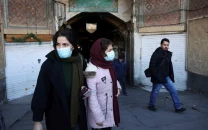Baby born from record-setting 27-year-old frozen embryo in US
Frozen in October 1992, the embryo stayed that way until February 2020 when it was adopted

A couple in the US state of Tennessee adopted and later gave birth from a 27-year-old frozen embryo, setting a new record for the longest-frozen embryo to have resulted in a birth, the BBC News reported.
Tina and Ben Gibson struggled with infertility for nearly five years before the former's parents saw a story about embryo adoption on a local news station.
The couple gave birth to a baby girl, Molly, in October of this year, breaking a record set only by her older sister, Emma, three years ago.
The embryo was frozen in October 1992, and stayed that way until February 2020, when the Gibsons adopted it.
"We're over the moon," Ms Gibson said. "I still get choked up."
"If you would have asked me five years ago if I would have not just one girl, but two, I would have said you were crazy," she said.
"That's the only reason that we share our story. If my parents hadn't seen this on the news then we wouldn't be here," said 29-year-old Gibson. "I feel like it should come full-circle."
The family connected with the National Embryo Donation Center (NEDC), a Christian non-profit that stores frozen embryos that in vitro fertilisation (IVF) patients decided not to use and chose to donate instead.
According to the NEDC, there are an estimated one million frozen human embryos stored in the US right now from which families can then adopt one and give birth to a child that is not genetically related to them.
Founded 17 years ago, the NEDC has facilitated more than 1,000 embryo adoptions and births, and now conducts around 200 transfers each year. Similar to a traditional adoption process, couples can decide if they would like a "closed" embryo adoption or an "open" one - allowing for some form of contact with the donor family.
The company’s marketing and development Director Mark Mellinger said that experience with infertility is common among families who seek embryo donations.
"I'd say probably 95% have encountered some sort of infertility", he said. "We feel honoured and privileged to do this work", and help these couples grow their families.
Couples are presented with 200-300 donor profiles, complete with the donor family's demographic history. The Gibsons had wanted a child for so long, the options were overwhelming.
Gibson gave birth to her first-born, Emma, in 2017 after adopting her embryo from the NEDC.
"We did not care what this baby looked like, where it came from," Gibson said. She sought advice from the NEDC where an employee told her to pick something "silly" and go from there.
"My husband and I are smaller people, and so we went through and narrowed it down by height and weight and looked for something similar to ours." That, she said, helped narrow down the search.
The Gibson's children, Molly and Emma, are genetic siblings. Both embryos were donated and frozen together in 1992, when their now mother was around a year old.
According to the NEDC, the shelf-life for frozen embryos is infinite. The time-frame is limited, however, by the age of the technology - the first baby born from an embryo frozen after IVF was born in Australia in 1984.
"It's entirely possible that there will someday be a 30-year-old embryo that comes to birth," Mellinger said.


















COMMENTS
Comments are moderated and generally will be posted if they are on-topic and not abusive.
For more information, please see our Comments FAQ